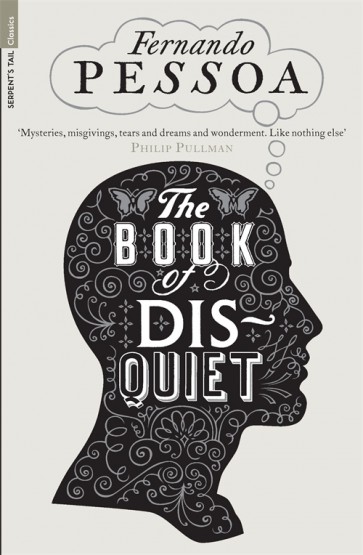For most of this year I’ve drifted halfheartedly from book to book, a dozen at once, my attention span measured in single chapters, until a book catches and I’m enthusiastic again. Recently my attention was caught by Fernando Pessoa’s The Book of Disquiet. It started me off on a blog post that went off on a long enough tangent that I still haven’t finished. It only just tonight occurred to me that I could post it in pieces, which is, for reasons that will become clear, kind of ironic.
The Book of Disquiet is a collection of vignettes, some as short as a single sentence, posing as the diary of an assistant bookkeeper named Bernardo Soares. Pessoa wrote under alternate identities that were more than pen names. He called them “heteronyms” and they had histories and personalities, like player characters in a literary game of Dungeons and Dragons.[1] Pessoa called Bernardo “me minus reason and affectivity.” Bernardo doesn’t do much beyond bookkeeping, writing, and dreaming, so he has plenty of time for self-examination and lots of interesting things to say about things that are not ostensibly interesting. “The wise man makes his life monotonous,” he writes, “for then even the tiniest incident becomes imbued with great significance.” This book is a deep dive into the experience of unimportance.

Bernardo is the type popular culture likes to portray as dead inside. In a Hollywood movie Bernardo might be a comic villain; if not, a wild adventure would teach him to loosen up and assert himself. Bernardo will not be loosening up and does not have an adventure; The Book of Disquiet is plotless. Between that and the title you might assume this is a depressing book, but it’s not. Some texts are anxious, or sad, but as often as not Bernardo feels satisfied with his circumscribed life. “In dreams I have achieved everything. I’ve also woken up, but what does that matter?”
The fragmented format makes for easy contrasts. The book doesn’t need to transition from one mood to another, it just places them next to each other like books on a shelf. In one text Bernardo is anxious, in the next he’s relaxed. In one he’s loquacious, then he stops with a sentence, barely able to get the words out. The texts explore different ideas but often highlight common themes through their juxtaposition. Thoughts on the common metaphor of life as a journey are followed by memories of an co-worker who collected travel brochures, going on vacations in his imagination.
I liked The Book of Disquiet enough to buy copies of both available English translations, by Richard Zenith and Margaret Jull Costa. I haven’t yet finished either version—ironically, given my quest for books that hold my attention, this is a good book to dip into at intervals. But I feel confident in my evaluation because The Book of Disquiet is inherently unfinished. Pessoa wrote The Book of Disquiet in bits, on labeled but loose pages, and died before he decided which texts to include, or in what order, or whether any given text was in its final form. (Some sections have blanks where Pessoa intended to go back and insert just the right words.) Every edition of The Book of Disquiet is unique. No selection or ordering is definitive, so both English translations include a different selection of texts in a different order. Richard Zenith even suggests that readers read the book in any order, as they please, like a modernist Choose Your Own Adventure. (To meditate on tedium, turn to section 118. If you’d rather study the back of the man in front of you, turn to section 40.)
Because The Book of Disquiet is one, I’ve been thinking about a kind of novel I might call—because I have to call it something, if I want to talk about it—a mosaic novel. [2] I don’t mean a novel written in pieces and assembled later, as The Book of Disquiet was. My definition of a mosaic novel, which I am admittedly working out as I go along, is a book made up of vignettes, short chapters between a few sentences and a few pages in length, each a distinct piece of writing rather than part of a single overarching plot. Mosaic novels aren’t strongly plotted, although subplots may recur now and then. The vignettes are often not in chronological order and build up to a theme or a big picture instead of a straightforward plot. The de-emphasizing of plot distinguishes the mosaic novel from the montage technique used by John Dos Passos in USA and John Brunner in Stand on Zanzibar. (Some of Kurt Vonnegut’s work feels closer, but is still too plotty for what I have in mind.) The novel in pieces is also not a short story collection, or a fixup novel, because the chapters aren’t complete stories. They’re scenes, sketches, vignettes, or essays.
Similar formats have been used in nonfiction, especially in books of philosophy or aphorisms. It’s a more natural form for nonfiction, so I’m focusing here on fiction: it’s interesting to see writing styles where they don’t obviously belong. Sometimes pieces of an otherwise conventional novel are written in mosaic form. For instance, Jo Walton’s recent novel Necessity includes multiple narrators. Most tell their stories chronologically but one, a robot named Crocus, writes in this subject-to-subject associational way. What’s more interesting is that I’ve read several entire novels in this format, or something like it. My next few posts will talk about novels by Renata Adler and Leena Krohn, plus a multi-author Doctor Who spinoff, and finish with some thoughts about why these books might appeal to me right now.
- At one point in The Book of Disquiet Bernardo even praises a poem written by another one of Pessoa’s heteronyms. ↩
- The term is already in use for something that isn’t quite what I’m describing here, but I figured I’d go ahead and repurpose it. ↩